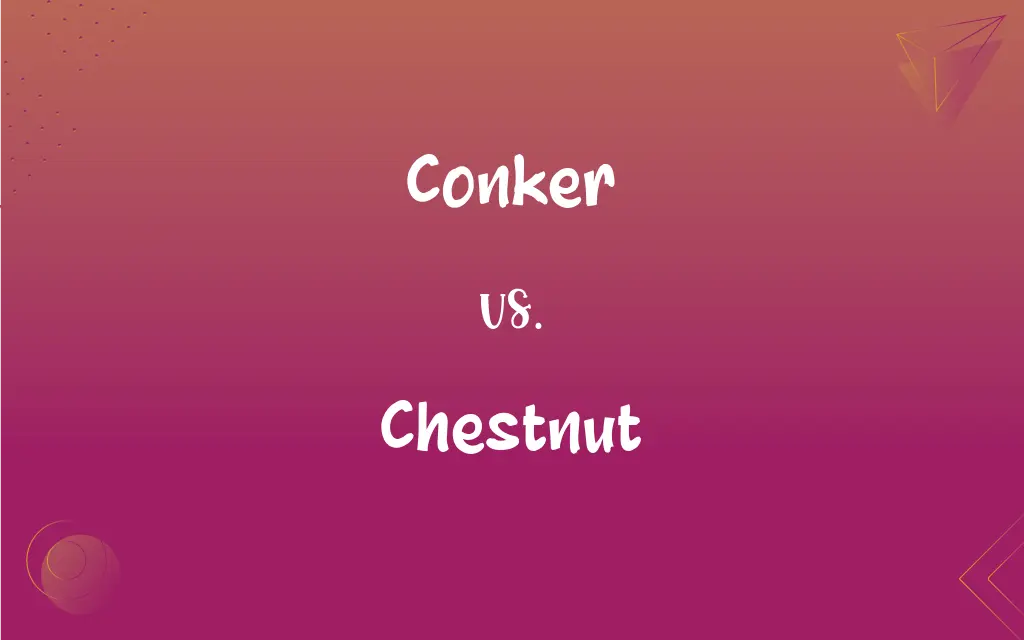Conker vs. Chestnut: What's the Difference?
Edited by Aimie Carlson || By Janet White || Updated on November 21, 2023
Conkers are the hard, shiny brown seeds of the horse chestnut tree, often used in games, while chestnuts are edible nuts from chestnut trees, used in cooking.

Key Differences
Conkers, derived from horse chestnut trees, are inedible seeds known for their glossy brown appearance and are often used in children's games. Chestnuts, on the other hand, are edible nuts from various species of chestnut trees, valued for their sweet, rich flavor and used in various culinary dishes.
The term 'conker' is primarily associated with the traditional children's game where the seeds are threaded and swung to break opponents' conkers. Chestnuts are often roasted, especially during the holiday season, and are a popular ingredient in both sweet and savory recipes.
Conkers have a smooth, shiny surface and a slightly poisonous nature, making them unsuitable for consumption. Chestnuts, recognizable by their sharp, spiny husks and sweet, starchy nuts, are a nutritious food source, rich in vitamins and minerals.
The horse chestnut tree, which produces conkers, is ornamental and its seeds are used for decorative purposes or in crafts. True chestnut trees, providing edible chestnuts, are cultivated for both their nuts and the wood, which is valued in furniture making and construction.
Conkers are a symbol of autumn and childhood play in many cultures, chestnuts are a staple in various cuisines, symbolizing autumnal and winter culinary traditions.
ADVERTISEMENT
Comparison Chart
Source
Horse chestnut tree
Various chestnut tree species
Edibility
Inedible and slightly toxic
Edible and nutritious
Use
Games, decoration
Culinary (roasted, in recipes)
Appearance
Smooth, shiny brown
Sharp, spiny husk; sweet, starchy nut
Cultural Significance
Associated with childhood games
Symbolic in culinary traditions
ADVERTISEMENT
Conker and Chestnut Definitions
Conker
A seed used in the traditional game of conkers.
He won the conker match with his exceptionally tough seed.
Chestnut
A nut rich in vitamins and minerals.
Chestnuts are a nutritious addition to any diet.
Conker
The hard, shiny seed of the horse chestnut tree.
The children collected conkers for their school project.
Chestnut
A nut used in various culinary dishes.
She added chopped chestnuts to the stuffing recipe.
Conker
Inedible seed often used for decorative purposes.
The conkers were strung up as a rustic autumn decoration.
Chestnut
Recognizable by its spiny husk and sweet, starchy interior.
He carefully peeled the spiny husk to reveal the sweet chestnut inside.
Conker
A symbol of autumn and childhood in many cultures.
Walking through the park, they found conkers scattered under the trees.
Chestnut
An edible nut from various chestnut tree species.
They roasted chestnuts over an open fire.
Conker
A seed known for its glossy, attractive appearance.
She admired the shiny conkers displayed on the mantelpiece.
Chestnut
A symbol of autumn and winter in culinary traditions.
The aroma of roasted chestnuts filled the holiday market.
Conker
A horse chestnut.
Chestnut
Any of several deciduous trees of the genus Castanea native to northern temperate regions, having alternate simple toothed leaves, and nuts that are enclosed in a prickly husk.
Conker
Con·kers A game in which two players swing horse chestnuts strung on string, with both players trying to use their own horse chestnut to shatter their opponent's.
Chestnut
The often edible nut of any of these trees.
Conker
One that conks or hits.
Conker
One that conks, as when styling hair.
Conker
(British) A horse chestnut, used in the game of conkers.
Conker
The inedible nutlike seed of the horsechestnut.
Conker
The inedible nutlike seed of the horse chestnut
FAQs
What's the main use of conkers?
Conkers are primarily used in children's games and for decoration.
Why can't you eat conkers?
Conkers contain aesculin, a compound that is toxic if ingested.
Are conkers poisonous?
Conkers are slightly toxic and should not be eaten.
What's the difference in appearance between conkers and chestnuts?
Conkers are smooth and shiny, while chestnuts have a spiny husk.
Can conkers be used in crafts?
Yes, their attractive appearance makes them popular for crafts and decorations.
Are chestnuts good for health?
Yes, chestnuts are nutritious, rich in vitamins and minerals.
Are chestnuts used in desserts?
Yes, chestnuts can be used in various desserts and sweet dishes.
How do you cook chestnuts?
Chestnuts are commonly roasted, but can also be boiled or used in recipes.
Can you find chestnuts year-round?
Chestnuts are seasonal, typically available in autumn and winter.
Are conkers harmful to pets?
Yes, conkers can be harmful if ingested by pets.
Can you eat chestnuts raw?
Chestnuts are usually cooked, as raw chestnuts can be hard and less flavorful.
Do conkers have any medicinal uses?
There's limited use of conkers in herbal medicine, though it's not widely recognized.
Are all chestnuts edible?
Most varieties are edible, but it's important to identify them correctly.
Do conkers have any symbolic meaning?
Conkers are often seen as a symbol of autumn and childhood.
Can chestnuts be frozen?
Yes, chestnuts can be frozen for longer storage.
Are chestnuts used in savory dishes?
Yes, chestnuts can be included in savory dishes like stuffings and soups.
How long do conkers last as decorations?
When dried, conkers can last several months as decorations.
How do you store chestnuts?
Chestnuts should be kept in a cool, dry place or refrigerated.
Is the conker game popular worldwide?
The conker game is mainly popular in the UK and some other countries.
What's the origin of the conker game?
The game dates back to the 19th century in England.
About Author
Written by
Janet WhiteJanet White has been an esteemed writer and blogger for Difference Wiki. Holding a Master's degree in Science and Medical Journalism from the prestigious Boston University, she has consistently demonstrated her expertise and passion for her field. When she's not immersed in her work, Janet relishes her time exercising, delving into a good book, and cherishing moments with friends and family.
Edited by
Aimie CarlsonAimie Carlson, holding a master's degree in English literature, is a fervent English language enthusiast. She lends her writing talents to Difference Wiki, a prominent website that specializes in comparisons, offering readers insightful analyses that both captivate and inform.































































